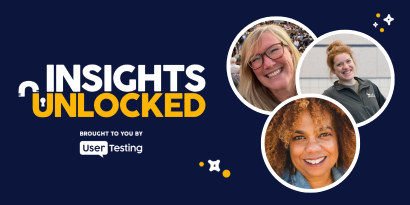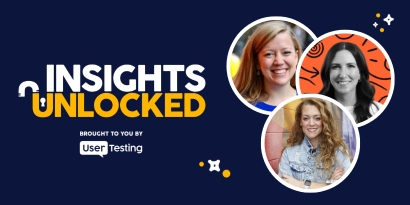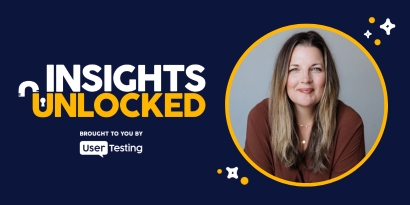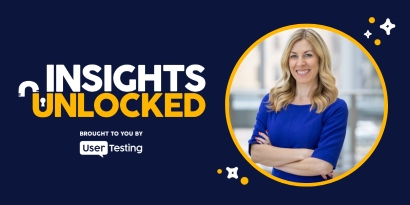
Episode 155 | January 27, 2025
Transforming healthcare UX with storytelling, data, and AI
Discover how healthcare leaders use storytelling and AI to improve UX, align stakeholders, and transform patient experiences.
How healthcare UX and storytelling are revolutionizing patient experiences
What if navigating the complexities of healthcare was as intuitive as ordering dinner on an app?
For Amy Stillman, VP of Design at Cedar, and Logan Hartline, Senior Director at HCA Healthcare, this isn’t just a dream—it’s a goal they’re actively pursuing. During the latest Insights Unlocked podcast, recorded live at The Human Insights Summit, these leaders shared how healthcare UX and storytelling in healthcare are transforming patient experiences and driving organizational change.
The power of storytelling in healthcare UX
Storytelling is emerging as a powerful tool in healthcare UX, helping organizations align stakeholders, prioritize improvements, and focus on what matters most: the patient. “Our superpower is storytelling,” Amy said. “There’s nothing better than hearing directly from the patient to create urgency for change.”
At Cedar, storytelling plays a central role in problem-solving. One recent initiative aimed to simplify the Medicaid eligibility process for patients. Cedar’s research revealed that emotional barriers often stopped patients from even applying for Medicaid. By sharing these stories with stakeholders through highlight reels and video testimonials, Cedar created alignment and urgency to act.

But storytelling alone isn’t enough—it needs to be paired with actionable metrics. “Healthcare speaks quant,” Amy explained. “We need to tie the story to metrics—whether it’s savings, user acquisition, or retention rates—to move the needle.”
“Combine the emotional weight of a good story with the undeniable logic of metrics.” – Amy Stillman
Leveraging AI to enhance healthcare UX
In addition to storytelling, AI innovations are paving the way for smarter, more efficient healthcare systems. Logan shared how HCA Healthcare is using predictive analytics to optimize labor and delivery staffing. “Rather than having nurses on standby for hours, we can predict when we’ll need additional staff and bring them in at the right time,” he said.
Cedar, meanwhile, is applying AI in call centers to ease staff workload and improve patient interactions. AI tools analyze calls, summarize conversations, and even tag reasons for calls—tasks that would otherwise burden call center employees. “AI helps shift the focus from call volume to call quality,” Amy said.
However, AI isn’t a one-size-fits-all solution. Cedar’s research revealed that patients appreciate AI-driven tools up to a point. “It turns out three minutes is the sweet spot,” Stillman said. “After that, frustration starts to build, and patients want to talk to a real person.”
“Our goal is simple: make healthcare less intimidating and more human, even through technology.” – Amy Stillman
Bridging the gap with metrics and insights
For healthcare UX practitioners, combining storytelling and data is key to driving results. Both guests emphasized the importance of aligning design improvements with measurable business outcomes.
Logan shared a real-world example from HCA Healthcare: a research project that analyzed how patients search for care online. The findings revealed that patients prioritize three factors: specialty, insurance coverage, and location. These insights, paired with highlight reels of patient frustrations, helped align stakeholders on where improvements were needed most.
“When you let the patient’s voice lead, stakeholders not only see the issues but also understand why they matter,” Logan said.
Advice for healthcare UX practitioners
If you’re looking to improve healthcare UX in your organization, the advice from Amy and Logan is simple:
- Start Small: Don’t overcomplicate the process. “Any feedback is better than no feedback at all,” Logan said.
- Prioritize Empathy: Use qualitative research to understand the emotional journey of your users.
- Leverage Technology Wisely: Use AI and digital tools to enhance—not replace—human interaction.
For those starting out, Amy emphasized the importance of building narratives that connect to metrics. “Tie your stories to numbers that resonate with decision-makers," she said. "That’s how you create alignment and drive change.”
The future of healthcare UX
As healthcare continues to evolve, the combination of healthcare UX strategies and storytelling in healthcare will play a pivotal role in shaping patient experiences. Whether it’s simplifying billing processes or optimizing emergency room workflows, leaders like Amy and Logan are proving that innovation begins with empathy and ends with measurable results.
“Our job is to bring patients to the front of the conversation," Amy said. "When we do that, we create real change.”
Episode Links
Consumer perceptions of AI in healthcare: This report explores how patients feel about integrating AI into their healthcare experiences, providing valuable insights into trust and adoption levels.
How storytelling brings experiences to life: This blog post delves into the power of storytelling in user experience design, emphasizing its role in creating meaningful connections with users.
Best practices for optimizing digital healthcare experiences: This article offers strategies for enhancing digital interactions in healthcare, focusing on user-centric design and the importance of empathy in creating effective solutions.










